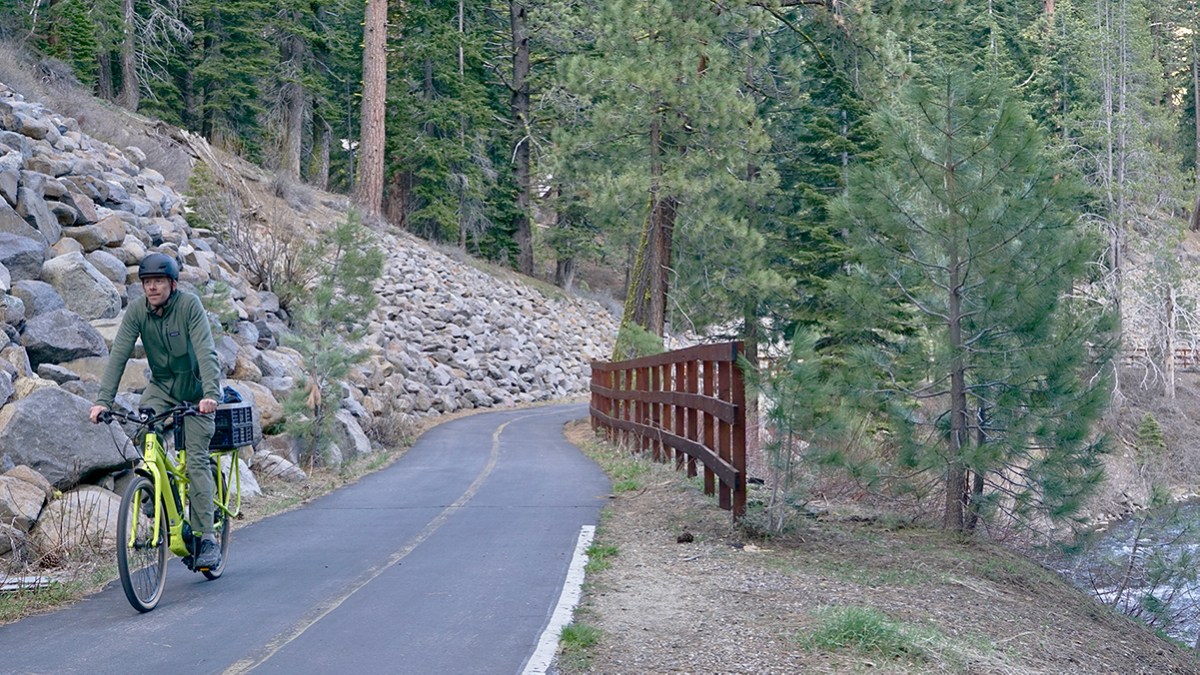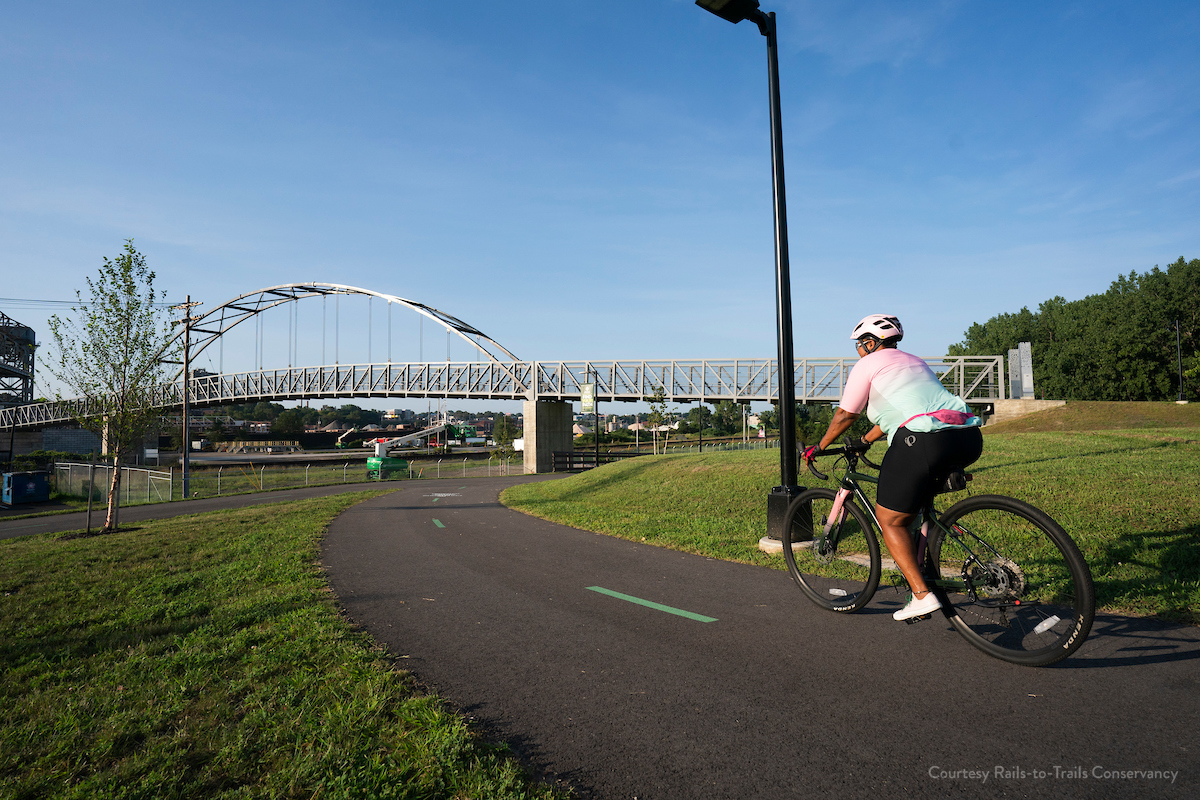Summer mornings are glorious in North Lake Tahoe. The sun shines, the winds are calm, the temperatures are mild, and the streets and sidewalks are nearly desolate. All this is part of why I began commuting to work on a cargo e-bike along the North Tahoe multiuse trail system. At the time, I wanted an alternative to driving to work every day. I toyed with the idea of purchasing a moped or motorcycle. But maintaining a motorcycle and finding a place to store it during the winter seemed like a stretch. These days, I’m fiercely determined to call myself a spring-fall bike commuter.
The pedal to work is by no means boring. At 8.6 miles in each direction with a mellow 400-foot gain and loss, it takes me about 30 minutes each way. Some days I load the bike up with climbing gear, skis or a splitboard. In the summer, I work as a guide at the via ferrata, a protected climbing route, on the famed rock face known as Tram Face in Olympic Valley. I love the chance to get my blood flowing before a day on the rock.
Despite the sweeping views that surround me, my favorite part of my commute is the bike path itself. It runs through the woods along the glittering Truckee River before cutting up into Olympic Valley. Relief washes over me the moment I nose my bike onto the paved trail, tucked away from cars and traffic. I was hit by a car while riding my bike nearly 10 years ago. Now, I feel less comfortable cycling on the road flanked by distracted drivers.

The path—a rail trail, or multipurpose path created from a former railroad corridor—has not always been here. This is the ancestral territory of members of the Washoe Tribe, Lake Tahoe’s original inhabitants. White settlers flocked to the Lake Tahoe region when, in 1848, immigrants discovered gold in California. The settlers depleted the area’s natural resources and displaced members of the Washoe Tribe from their land. The route I now pedal was first a toll road for stagecoaches and, later, a narrow-gauge railroad corridor that transported visitors from Truckee to Tahoe City.
It is one segment of a network of multiuse trails that will ultimately connect the town of Truckee, California, to the towns and resorts of North Lake Tahoe with 62 miles of continuous trails for biking, running, walking and other activities. The trail I ride daily will eventually link up with the Truckee River Legacy Trail and the longer Tahoe-Pyramid Trail, which will follow the Truckee River from its start at Lake Tahoe to its terminus at Pyramid Lake, Nevada. When complete, it will descend 2,500 feet and extend 114 miles.
A 1983 amendment to the National Trails System Act helped create voluntary agreements between railway companies and trail sponsors so out-of-service rail corridors could be developed into trails. It’s part of the reason trails like the one I ride each day are becoming increasingly common across the U.S. Since the amendment, organizations like Rails-to-Trails Conservancy (RTC) began developing and redefining trail networks to bring communities together.
“Our focus is on creating safe spaces for people to be able to walk, bike and be active outside,” said Brandi Horton, vice president of communications for RTC. The organization has supported the creation of about 41,000 miles of multiuse trails across the U.S. “In many places across the country, we can make using trails part of our everyday lives. We can, say, take our kids, pop them on their bikes and go to school, and know that we are going to be safe. … That didn’t exist before and it’s happening for more and more communities in real time.”

The Cleveland Foundation Centennial Lake Link Trail in Ohio. Photo: Jason Cohn; courtesy Rails-to-Trails Conservancy
The goal is to connect those trails to maximize the benefit to people in their everyday lives, Horton said. The organization is pursuing this in a few different ways. Its TrailNation initiative aims to build and connect 150-plus trail networks nationwide. Meanwhile, TrailLink, a free website and app, helps outdoorists and commuters discover trails around the country with maps that include route details and specifications.
One of RTC’s biggest projects is The Great American Rail-Trail, the nation’s first cross-country multiuse trail, extending from Washington D.C. to Washington state. The trail is currently 55% percent complete; when finished it will stretch 3,700 miles. These projects are just the tip of the iceberg for the development of trails nationwide, Horton said.
Demand for trails for walking, running and biking is growing. Trail use on average increased 9.5% between 2021 and 2022, according to data RTC collected from 26 Eco-Counters located on multiuse trails across the country. Trail use in 2022 was up 45% from 2019.
Like others, I enjoy connecting with nature when I’m on the trail. I take comfort in knowing I have a spot to ride away from moving cars. I get to breathe the mountain air and know that by riding to work I may minimize my impact on the planet in some slight way.
Every time I hop on my bike it’s an adventure. One day, I cruised by a man on a Penny Farthing (also known as a high-wheel bicycle). He was searching for a multi-tool to fix a component on his bike. I slowed down, and we started chatting. In a matter of minutes, I was enamored with his bike. He answered all my questions about this special replica before locating a multi-tool station, and then we parted ways. It was a good reminder of our connection to nature and the trails that help to move us around.
Editors’ Note: REI Cooperative Action Fund, a 501(c)(3) public charity, provided $100,000 in 2023 to Rails-to-Trails Conservancy in support of the Great American Rail-Trail.
Fund Better Trails to Run, Bike and Roll
Connecting pedestrian and bike trails would help make it easier, safer, cleaner, and more efficient for people of all ages and abilities to get where they need to go—without a car. Take action through the REI Cooperative Action Network to support more such paths.


